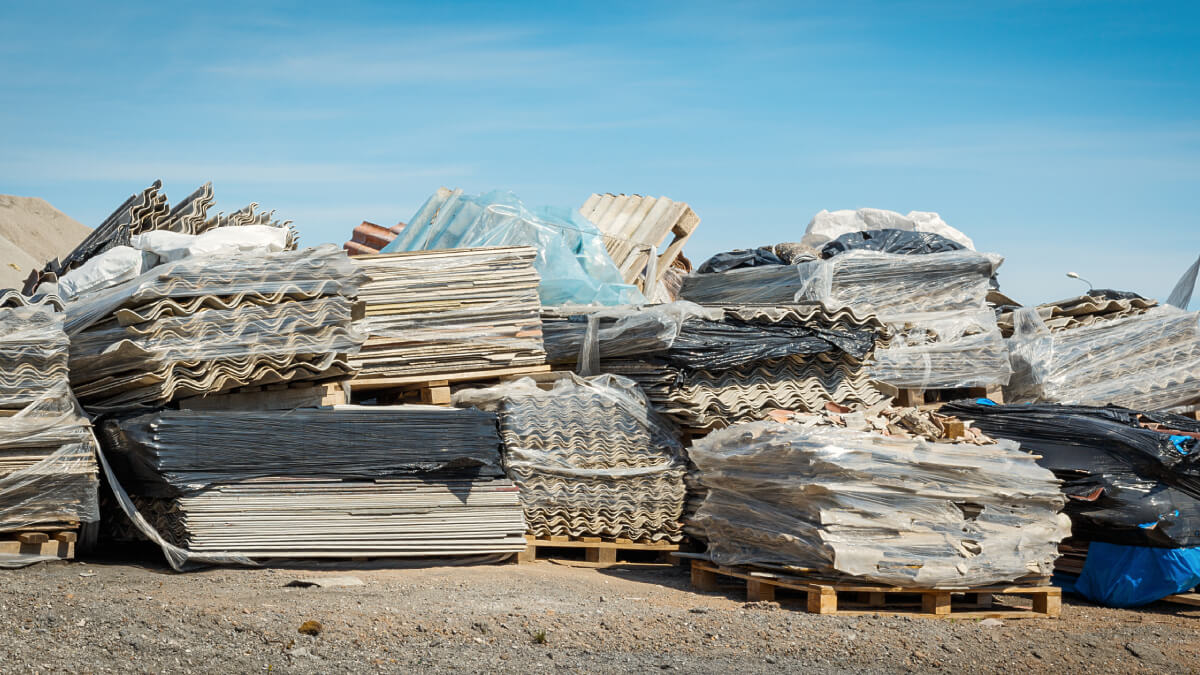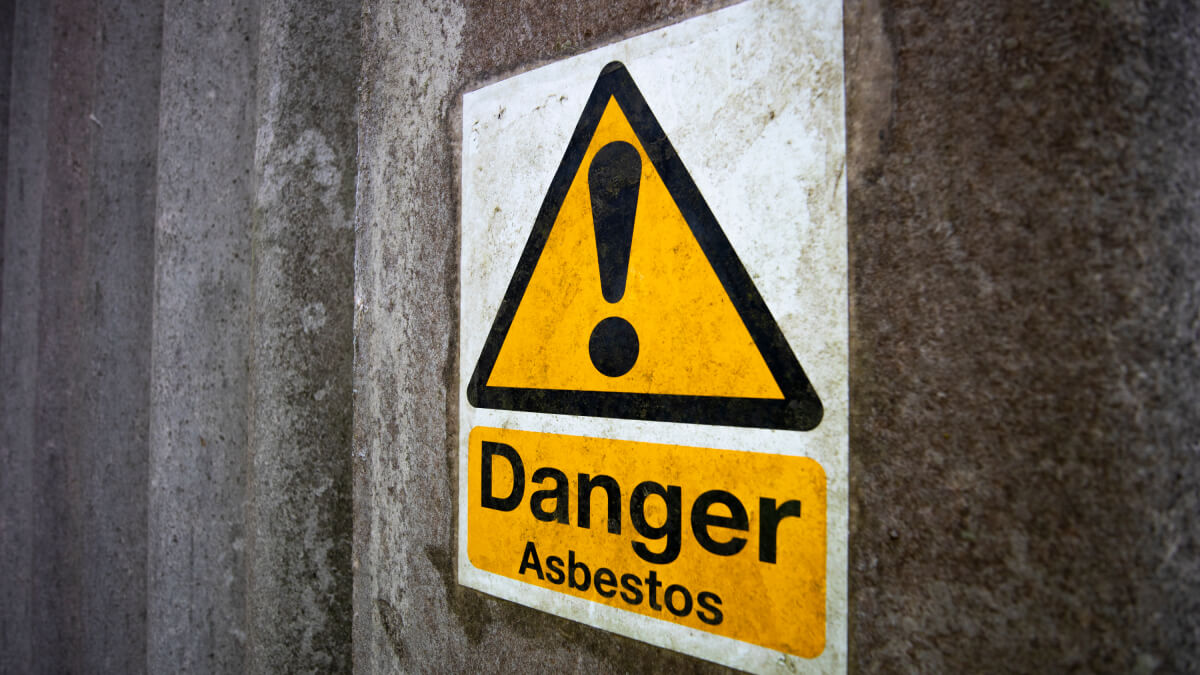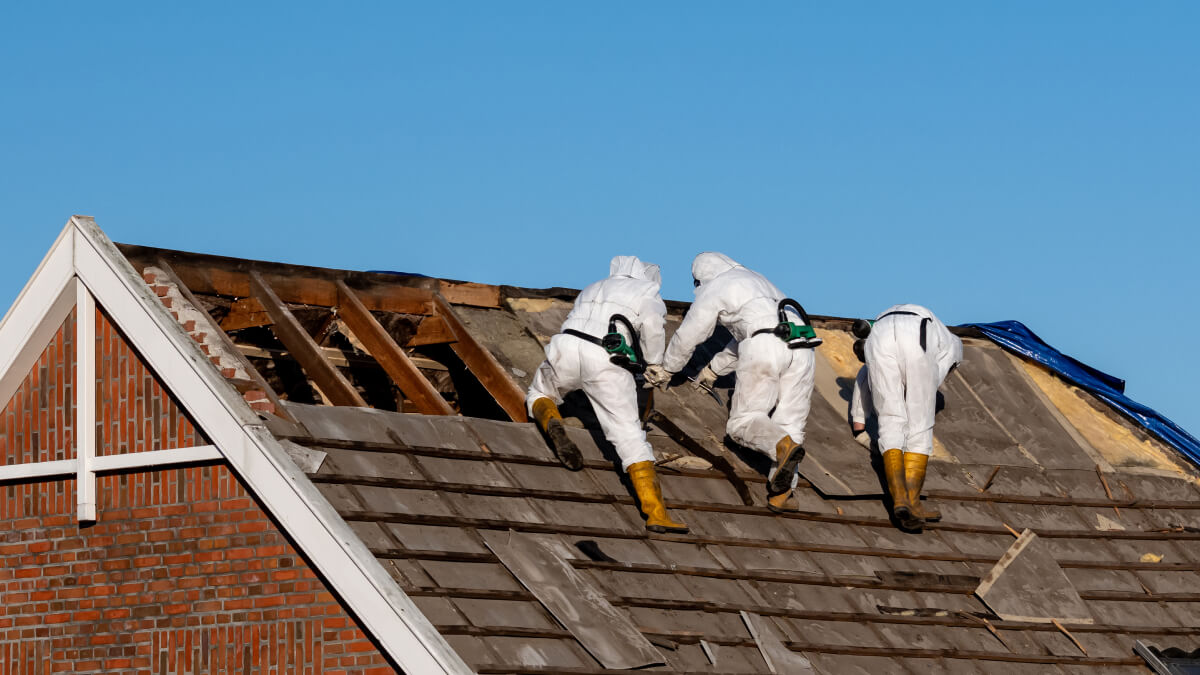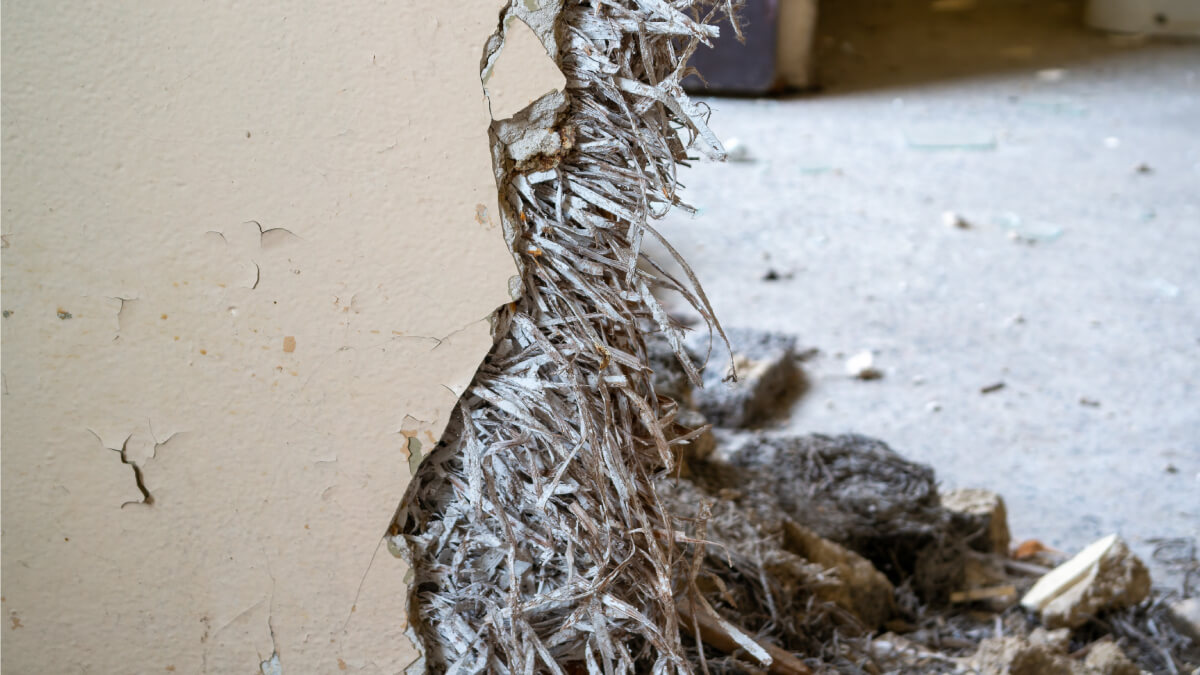Despite being banned decades ago, asbestos continues to be a serious problem in properties throughout the UK. This hazardous material lurks in countless homes and buildings, posing a risk to anyone who might disturb it during construction or renovation work.
Working with asbestos requires extensive training and know-how to ensure everyone’s safety. Fortunately, the team at Merlin Scaffolding have both of these things and will be using our expertise to explain everything you need to know about asbestos safety. So, let’s dive into it: what is asbestos, and how can it be controlled?
What Is Asbestos? Everything You Need To Know
The presence of asbestos in the UK dates back to the 1870s, when this seemingly miracle material was first introduced to British construction. It quickly became extremely popular due to its fire-resistant properties and durability. Building materials containing asbestos were very common from 1930-1960, meaning millions of properties built during this era potentially contain these dangerous fibres.
Despite this widespread use, the dangers of asbestos were actually identified in the early 1900s. However, it took many decades for proper action to be taken, and the harmful effects of asbestos exposure are still felt today. Understanding asbestos is crucial for anyone working in construction or planning renovation work.
In this comprehensive guide, we’ll cover everything you need to know:
- Where Does Asbestos Come From?
- What Materials Contain Asbestos?
- How Dangerous Is Asbestos?
- What Are The Symptoms Of Asbestos Poisoning?
- When Was Asbestos Banned?
- What Does The Control Of Asbestos Regulations Apply To?
- How To Identify Asbestos
- How To Test For Asbestos

Where Does Asbestos Come From?
Asbestos is a naturally occurring fibrous mineral found in certain types of rocks around the world. It’s not a man-made substance – nature created this material millions of years ago through geological processes. The fibres are incredibly strong and heat-resistant, which made asbestos extremely attractive to manufacturers and builders for many decades.
Asbestos can be found all over the world, but the biggest producers are Russia, Kazakhstan, and China. These countries continue to mine and export asbestos despite the known health risks. The material is extracted through open-pit mining, where large machines strip away layers of earth to reach the asbestos-containing rock beneath.
Once mined, the raw asbestos is processed and refined into various forms that can be mixed with other materials or used on its own. This processing creates the fine fibres that make asbestos so dangerous when they become airborne.

What Materials Contain Asbestos?
For decades, asbestos was one of the most common materials found in all kinds of construction products. As a result, there are many items that still contain asbestos in UK homes today. Here are the most common ones:
- Insulation: Asbestos was widely used to insulate pipes, boilers, and loft spaces. This loose-fill insulation was particularly popular because it didn’t burn and provided excellent thermal protection. Unfortunately, it’s also one of the most dangerous forms of asbestos because the fibres can easily become airborne.
- Roofing: Many roof tiles, sheets, and guttering systems contain asbestos cement. These materials were durable and weather-resistant, making them extremely popular for both residential and commercial buildings.
- Flooring: Vinyl floor tiles and the adhesives used to stick them down often contain asbestos. These tiles were common in kitchens, bathrooms, and commercial spaces throughout the mid-20th century.
- Textiles: Asbestos fibres were woven into fabrics to create fire-resistant clothing, curtains, and other textiles. Theatre curtains, in particular, often contain asbestos to prevent fires from spreading.
- Automotive Parts: Car brake pads, clutches, and gaskets frequently contain asbestos due to its heat-resistant properties. Mechanics working on older vehicles are at particular risk of exposure.
- Household Appliances: Items like ironing board covers, oven gloves, and even some paints contain asbestos. Hairdryers manufactured before the 1980s also commonly contain asbestos insulation.

How Dangerous Is Asbestos?
Exposure to asbestos is extremely dangerous. Asbestos still kills around 5,000 workers each year in the UK – that’s more than the number of people killed in traffic accidents. This makes asbestos one of the biggest occupational health hazards in the country.
Asbestos becomes dangerous when it’s disturbed, and fibres become airborne. When you breathe in these microscopic fibres, they can become lodged in your lungs and other organs, where they remain for life. Your body cannot break down or remove these fibres naturally.
What makes asbestos particularly difficult to manage is that asbestos-caused diseases won’t affect you straight away. The symptoms can take 20-50 years to develop, meaning people exposed decades ago are only now becoming ill. Even short-term exposure to asbestos can lead to a high risk of disease later in life.
A tragic example of this delayed effect can be seen in the health impacts of the 9/11 terrorist attacks on the World Trade Center. Many people are now suffering the effects of asbestos exposure from that single day, as the collapsing towers released massive amounts of asbestos dust into the air.
Asbestos exposure can cause several serious diseases:
- Mesothelioma: This is a rare but aggressive form of cancer that affects the lining of the lungs, heart, or abdomen. It’s almost exclusively caused by asbestos exposure and is usually fatal.
- Asbestos-related lung cancer: This type of lung cancer is directly linked to asbestos exposure and can develop many years after initial contact with the fibres.
- Asbestosis: This is a serious scarring of the lungs caused by breathing in asbestos fibres over time. It causes breathing difficulties and can be progressive, meaning it gets worse over time.
- Pleural thickening: This condition involves thickening of the lining around the lungs, which can cause chest pain and breathing difficulties.

What Are The Symptoms Of Asbestos Poisoning?
Prolonged exposure to asbestos fibres can cause asbestos poisoning or asbestosis. The symptoms often don’t appear until many years after exposure, which makes early detection difficult. Here are the main symptoms to watch out for:
- Shortness of breath: This is often the first symptom people notice. It may start as mild breathlessness during physical activity but can progress to difficulty breathing even at rest.
- A persistent, dry cough: This cough doesn’t produce phlegm and doesn’t respond to typical cough treatments. It may be worse at night or when lying down.
- Chest tightness or pain: People often describe feeling like they have a tight band around their chest, or they may experience sharp pains when breathing deeply.
- Dry and crackling sounds in your lungs when you inhale: These sounds, called “crepitations,” can be heard with a stethoscope and indicate scarring in the lungs.
- Fingertips and toes that appear wider and rounder than usual (clubbing): This is a sign that your body isn’t getting enough oxygen, and it indicates advanced lung disease.
If you experience any of these symptoms and have a history of potential asbestos exposure, it’s crucial to see a doctor immediately. Early detection and treatment can help manage symptoms and slow the progression of asbestos-related diseases.

When Was Asbestos Banned?
Asbestos was fully banned in the UK in November 1999, but restrictions began being introduced as early as 1985. The ban was implemented gradually, with different types of asbestos being prohibited at different times as the health evidence mounted.
Many countries across Europe began introducing asbestos bans around the same time, recognising the serious health risks posed by this material. Today, the World Health Organisation reports that 67 countries have introduced national bans on asbestos, though many countries still allow its use.
It’s important to remember that the ban only applies to new uses of asbestos. All the asbestos that was installed before 1999 is still in place in millions of buildings across the UK. This is why asbestos remains such a significant concern for anyone working in construction, renovation, or maintenance.

What Does The Control Of Asbestos Regulations Apply To?
The Control of Asbestos Regulations 2012 was introduced to update previous regulations and provide better protection for those at risk of asbestos exposure. These regulations are comprehensive and apply to most non-domestic properties and the common areas of some domestic properties, such as blocks of flats.
The regulations cover several key areas, including the duty to manage asbestos in buildings, requirements for asbestos surveys, and strict controls on any work that might disturb asbestos-containing materials. They also set out licensing requirements for certain types of asbestos work.
Among other important updates, these regulations introduced mandatory asbestos training for employees who may be exposed to asbestos while working in buildings constructed before 2000. This training requirement recognises that virtually any building work in older properties carries the risk of asbestos exposure.
For scaffolding companies like Merlin Scaffolding, these regulations are particularly important. Our team regularly works on older buildings that may contain asbestos materials, which is why all our staff receive comprehensive asbestos awareness training and strict safety protocols are continually put in place. For more information on our scaffolding in Milton Keynes and how we manage asbestos on older properties, feel free to contact us.

How To Identify Asbestos
While there are signs that materials might contain asbestos, it’s very difficult to identify with certainty, and you shouldn’t make assumptions without consulting trained professionals. The challenge with identifying asbestos is that the fibres are microscopic and invisible to the naked eye.
The appearance of asbestos changes dramatically from product to product, and asbestos-containing materials generally look very similar to non-asbestos products. This similarity means that even experienced professionals can’t always identify asbestos just by looking at it.
However, there are some general guidelines about when asbestos is more likely to be present. Any building constructed before 2000 could potentially contain asbestos, with the highest risk in buildings from the 1930s-1980s. If you’re planning any work that might disturb building materials from this era, it’s essential to assume asbestos may be present until proven otherwise.
What Does Asbestos Look Like?
As previously mentioned, asbestos can take on many different forms depending on how it was used. Here are some types you can look out for, though remember that professional testing is always required for confirmation:
- Loose fill asbestos: This is commonly found in lofts and cavity walls and looks loose and fluffy. It can appear blue, white, or grey in colour.
- Asbestos sprayed coating: This was typically sprayed onto piping, structural steelwork, or used as ceiling insulation. It can look lumpy and is usually white or grey in colour. You might find this in industrial buildings, schools, or large commercial properties.
- Asbestos artex: This was a popular style of ceiling coating throughout the 20th century, particularly in the 1960s and 1970s. It can be identified by its distinctive swirly, bumpy textured design. Not all Artex contains asbestos, but any applied before 1980 should be treated with caution.
- Asbestos floor tiles: These tiles usually look thin and brittle, but they’re typically very difficult to distinguish from normal vinyl floor tiles without testing. They were particularly common in commercial buildings, schools, and hospitals.

How To Test For Asbestos
To determine whether a material contains asbestos with certainty, it needs to be tested in a laboratory. DIY asbestos testing kits are available, but they risk disturbing the asbestos and often provide inaccurate results. Professional testing is always the safest and most reliable option.
A laboratory test involves several steps:
- Sample collection: A trained professional will carefully collect a small sample of the suspected material using proper safety equipment and procedures. This process is designed to minimise the release of any fibres into the air. The sample is then sealed in a special container and labelled for identification.
- Testing: The laboratory will use one of several advanced testing methods:
- Polarised Light Microscopy (PLM): This is the most common method and can identify asbestos fibres and determine the type of asbestos present.
- Transmission Electron Microscopy (TEM): This method can detect very small amounts of asbestos and is often used when PLM results are unclear.
- Scanning Electron Microscopy (SEM): This technique provides detailed images of fibres and can confirm whether they are asbestos.
- Results and reporting: The laboratory will provide a detailed report stating whether asbestos is present, what type it is (if found), and the percentage of asbestos in the material. This information is crucial for determining what safety measures are needed if any work is to be carried out.
Stay Asbestos Safe With Merlin Scaffolding
Throughout this article, we’ve explored the serious risks associated with asbestos and the importance of proper identification and control measures. As we’ve seen, asbestos remains a significant hazard in countless properties across the UK, and anyone working in construction needs to be aware of these risks.
When planning your next construction or renovation project, choosing a scaffolder in Milton Keynes who understands asbestos risks is crucial for your safety. At Merlin Scaffolding, our team has received extensive asbestos awareness training, and we understand the precautions needed when working on older buildings.
Contact our team to discuss your project requirements. With our commitment to safety and extensive experience, we’ll ensure your scaffolding needs are met with the highest standards of professionalism and care, while keeping everyone safe from asbestos exposure.
